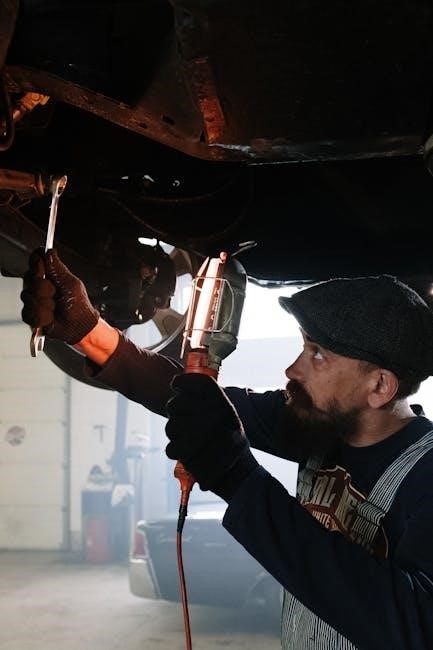
The Craftsman Garage Door Opener Manual is a comprehensive guide for installing, configuring, and maintaining your opener. It ensures safe and efficient operation, helping homeowners maximize performance and longevity.
1.1 Importance of the Manual for Installation and Maintenance
The Craftsman Garage Door Opener Manual is a crucial resource for ensuring proper installation, maintenance, and troubleshooting. It provides detailed instructions to guide homeowners through the setup process, helping them avoid common mistakes. The manual emphasizes safety guidelines to prevent injuries or damage, such as disabling locks before installation and operating the opener at the correct voltage. By following the manual, users can troubleshoot issues like unexpected opening or programming problems. Regular maintenance tips, such as inspecting parts and adjusting limits, ensure the opener performs optimally. This guide is essential for maximizing the lifespan and functionality of your garage door opener, making it a must-have for both new and experienced users.
1.2 Overview of Craftsman Garage Door Opener Models
Craftsman offers a variety of garage door opener models designed to meet different needs and preferences. These include chain-drive, belt-drive, and screw-drive systems, each with unique advantages. Chain-drive models are durable and cost-effective, while belt-drive systems are quieter and ideal for homes where noise is a concern. Screw-drive openers provide smooth operation and require less maintenance. Many models feature advanced technologies like MyQ smart home compatibility, allowing users to control their garage doors remotely. Horsepower options range from 1/2 to 1.5 HP, catering to lightweight and heavy-duty garage doors. Craftsman also offers energy-efficient and battery backup models for added convenience. Understanding the differences helps users choose the best model for their garage door type and lifestyle.

Understanding the Components of Your Garage Door Opener
The Craftsman garage door opener consists of a motor, rail system, belt or chain, springs, sensors, and remote controls. These components work together to ensure smooth operation.
2.1 Key Parts and Accessories Included in the Package
The Craftsman garage door opener package includes essential components like the motor unit, rail system, belt or chain, pulleys, and springs. Accessories such as remote controls, wall buttons, and safety sensors are also provided. Additionally, the package contains mounting hardware like screws, bolts, and brackets. A comprehensive manual is included for installation and troubleshooting. Some models may include extra features like a battery backup, keypad, or smart hub for Wi-Fi connectivity. It’s important to verify all parts are present before starting installation to ensure smooth assembly and operation.
2.2 Tools Required for Installation and Adjustment
For the installation and adjustment of your Craftsman garage door opener, you’ll need several essential tools. A screwdriver set, including both flathead and Phillips head, is crucial for assembling and adjusting components. An adjustable wrench or socket set will help with bolts and nuts. Pliers may be necessary for gripping small parts, and a level ensures proper alignment. A ladder is often needed for reaching higher areas; Additional tools like a tape measure, drill, and utility knife can assist with precise measurements and minor adjustments. Safety equipment, such as gloves and safety glasses, is also recommended to protect yourself during the process.

Safety Precautions and Instructions
Always follow safety guidelines to avoid accidents. Ensure the garage door is closed before installation. Keep children away during setup. Wear protective gear like gloves and safety glasses. Properly disconnect power before adjustments. Never stand under a moving garage door. Check for loose parts regularly. Follow manual instructions meticulously to prevent injuries or damage. Maintain a clean workspace to avoid tripping hazards.
3.1 General Safety Guidelines for Installation and Operation
Adhere to all safety guidelines to ensure a secure installation and operation of your Craftsman garage door opener. Always disconnect the power source before performing any adjustments or maintenance. Wear protective gear, such as gloves and safety glasses, to minimize risks. Ensure the garage area is clear of obstacles and keep children and pets away during installation. Never attempt to manually stop or block the door while it is moving. Regularly inspect the door and opener for worn or damaged parts. Follow the manufacturer’s instructions carefully to avoid malfunctions. Never stand under a moving garage door, as it can cause serious injury. Proper safety practices ensure smooth and safe operation.
3.2 Warnings to Prevent Injury or Damage
Exercise extreme caution to prevent accidents and damage when working with your Craftsman garage door opener. Avoid entrapment by ensuring fingers and limbs are clear of moving parts. Never allow children to play with the opener or remote controls. Keep the garage door balanced, as an unbalanced door can cause sudden, unpredictable movement. Do not attempt to modify or repair the opener beyond the instructions provided, as this may lead to malfunction. Always ensure the door is fully closed before leaving it unattended. Be cautious of pinch points, such as between the door and frame. Regularly inspect springs and cables, as they can cause injury if damaged. Never operate the door while standing beneath it, and keep the area clear of obstructions during operation.

Installation Process
Begin by unpacking and assembling all components, then mount the opener securely. Connect the motor, rails, and sensors, ensuring proper alignment and tight connections for smooth operation.
4.1 Step-by-Step Guide to Assembling the Opener
Start by unboxing and organizing all components. Attach the rail segments together, ensuring they align properly. Mount the motor unit to the ceiling bracket, securing it firmly. Install the trolley and attach it to the rail. Connect the chain or belt to the trolley and door arm. Carefully align the safety sensors and wire them to the motor. Use a ladder safely and ensure all bolts and screws are tightened. Follow the manual for wiring the wall button and remote. Test the opener by manually lifting the door to ensure smooth operation. Double-check all connections and refer to the manual for specific torque settings and alignment details.
4.2 Compatibility with Different Garage Door Types
Craftsman garage door openers are designed to work with various garage door types, including sectional, single-panel, and hinged doors. Ensure compatibility by checking the door’s weight and dimensions against the opener’s specifications. Sectional doors are the most common and typically require standard installation. Single-panel doors may need additional reinforcement for smooth operation. Hinged doors, often found in older homes, can be adapted with specialized brackets. Roller doors, which slide horizontally, may require a different mounting system. Always verify the door type and opener compatibility before installation to ensure proper function and safety. Refer to the manual for specific recommendations and adjustments for your door type.
4.3 Instructions for Sectional and Hinged Garage Doors
For sectional garage doors, ensure tracks are securely attached to the door frame and ceiling. Align the opener’s rail with the center of the door and attach the carriage assembly. Hinged garage doors require additional steps, such as reinforcing the door frame and installing hinge brackets. Attach the opener’s arm to the door and wall bracket, ensuring proper alignment. Always follow torque and force specifications to avoid damage. Double-check all connections and test the door’s balance before operating. For hinged doors, consult the manual for specific bracket installation guidelines. Ensure smooth operation by verifying door alignment and adjusting springs if necessary. Safety checks are essential before final operation.

Programming and Configuration
Program remotes and smart features, ensuring compatibility with your opener. Adjust sensitivity and limits for smooth operation, following manual guidelines for optimal performance and security.
5.1 How to Program the Garage Door Opener
To program your Craftsman garage door opener, start by locating the “Learn” button on the motor unit. Press and release it to enter programming mode, indicated by a blinking light. Next, press and hold the remote control button you wish to program until the opener’s light stops blinking, confirming the code has been set. For wall-mounted controls, follow similar steps by pressing the “Learn” button and then the desired button on the control panel. Ensure all remotes and accessories are synced for consistent operation. Refer to your manual for specific timing and button sequences, as these may vary by model. Always test the programmed devices to ensure proper function and connectivity.
5.2 Setting Up Remote Controls and Smart Features
Setting up remote controls and smart features for your Craftsman garage door opener enhances convenience and functionality. Start by ensuring your remote control is compatible with your opener model. Sync the remote by pressing the “Learn” button on the motor unit and then the remote button until the opener’s light confirms synchronization. For smart features, download the MyQ app and follow in-app instructions to connect your opener to Wi-Fi. Enable features like remote access, notifications, and voice control through Amazon Alexa or Google Assistant. Test all functions to ensure proper connectivity. Refer to your manual for model-specific guidance, as some features may require additional setup steps. This setup ensures seamless integration and advanced control over your garage door system.
5.3 Adjusting Open and Close Limits
Adjusting the open and close limits of your Craftsman garage door opener ensures smooth operation and prevents damage. Locate the adjustment controls, typically found on the motor unit or in the settings menu of your remote or app. To set the open limit, fully open the door and use the adjustment screw or digital controls to stop it at the desired position. For the close limit, repeat the process with the door fully closed. Test the door to ensure it stops accurately at both limits. If using a smart feature, sync the settings through the MyQ app. Always refer to your manual for specific instructions, as methods may vary slightly by model. Proper adjustment ensures safe and efficient door operation.

Maintenance and Troubleshooting
Regular lubrication of moving parts and inspection of belts or chains ensure smooth operation. Troubleshoot issues like sensor misalignment or power outages to maintain functionality. Clean sensors and reset systems as needed for optimal performance.
6.1 Regular Maintenance Tips for Optimal Performance
Regular maintenance ensures your Craftsman garage door opener operates efficiently. Lubricate moving parts like rollers and springs annually to reduce friction. Inspect belts or chains for wear and tear, replacing them if damaged. Check the trolley track for alignment and cleanliness. Test the door balance by disconnecting the opener; it should stay in place without drifting. Clean the sensors and ensure they are properly aligned. Replace the battery in remote controls every 3-5 years. Schedule annual professional inspections for complex systems. Keep the opener’s motor and circuit board free from dust. Regularly test safety features like auto-reverse to ensure they function correctly.
6.2 Common Issues and How to Resolve Them
Common issues with Craftsman garage door openers include the door not opening, remote malfunction, or unusual noise. For a door that won’t open, check if the opener is unplugged or if the circuit breaker tripped. Ensure the remote has a clear line of sight and replace the battery if weak. If the door reverses unexpectedly, adjust the sensitivity settings or clean the sensors. For noisy operation, lubricate the rollers and springs. If the opener runs but the door doesn’t move, inspect the chain or belt for breaks. Always unplug the unit before attempting repairs. Consult the manual for specific error codes and solutions.

6.3 Understanding Error Codes and Indicators
Craftsman garage door openers use error codes and indicators to signal potential issues. These codes, often displayed through LED lights or digital displays, help diagnose problems quickly. For example, a blinking red light may indicate a sensor obstruction, while a solid yellow light could signal a misalignment. Refer to the manual’s error code chart to decode these indicators. Common codes include those for faulty sensors, motor overload, or misaligned rails. Understanding these codes allows for precise troubleshooting and minimizes downtime. Always consult the manual or contact customer support if unsure about a specific code’s meaning. Regular checks can prevent issues from escalating, ensuring smooth operation.

Emergency Procedures
Emergency procedures ensure safe operation during opener malfunctions. Learn manual door operation and emergency lock release for secure and controlled access when needed. Always prioritize safety.
7.1 Manual Operation of the Garage Door
To manually operate your garage door, first disconnect the opener by pulling the emergency release cord. This allows you to open or close the door without motor assistance. Always ensure the door is balanced before manual operation to avoid injury or damage. Never attempt to manually operate the door if it is stuck or misaligned, as this can cause further issues. If the door is too heavy, consider seeking assistance. For sectional doors, lift from the handles provided, while hinged doors may require different handling. Always inspect the door for damage before manual operation and ensure it is secure when closed. Follow these steps to maintain safety and control during emergencies.
7.2 Releasing the Emergency Lock
Your Craftsman garage door opener is equipped with an emergency lock feature for added security. To release the lock, locate the emergency release mechanism, typically a cord or handle near the door. Pull the cord firmly downward to disengage the lock. This allows the door to open manually if the opener is malfunctioning. Always ensure the door is secure before releasing the lock to prevent unintended movement. After releasing, check the door’s balance and alignment before resuming normal operation. If the lock is stubborn, consult your manual for model-specific instructions. Remember to re-engage the lock once the issue is resolved to maintain security and safety. Follow these steps carefully to avoid any potential hazards or damage.

Warranty and Customer Support
Craftsman offers comprehensive warranty coverage for garage door openers, ensuring durability and performance. Dedicated customer support provides assistance with inquiries, repairs, and troubleshooting for a seamless experience.
8.1 Understanding the Warranty Terms
The Craftsman garage door opener is backed by a limited warranty, providing coverage for parts and labor for a specified period. Typically, the warranty lasts 1 to 5 years, depending on the model and components. It covers defects in materials and workmanship under normal use. Registration may be required to activate the warranty. Certain conditions, such as misuse or unauthorized modifications, may void the coverage. For details, review the warranty document included in the manual or visit the official Craftsman website. Understanding the terms ensures protection and support for your investment. Proper registration and adherence to guidelines maximize warranty benefits. Always retain the purchase receipt for verification purposes.
8.2 Contacting Craftsman Customer Service
For assistance with your Craftsman garage door opener, contact customer service via phone, email, or live chat through their official website. Phone support is available Monday through Friday, 8 AM to 8 PM EST. Visit the website to find the contact form or chat option. When reaching out, have your model number ready for faster service. Craftsman also provides a comprehensive FAQ section and troubleshooting guides online. Representatives can help with warranty claims, repair requests, or technical inquiries. Ensure to verify the official website URL to avoid unauthorized support channels. Timely assistance is available to address any concerns, ensuring smooth operation of your garage door opener.

Additional Resources
Visit the official Craftsman website for downloadable manuals, video guides, and FAQs. Explore model-specific instructions and troubleshooting tips to enhance your garage door opener experience.
9.1 Downloading the Latest Manual Online
To access the latest version of the Craftsman garage door opener manual, visit the official Craftsman website. Navigate to the “Support” or “Manuals” section, where you can search for your specific model by name, number, or description. Once located, click the download link to retrieve the PDF version. Ensure your model number is correct for accurate instructions. The manual is available for both current and legacy models, making it easy to find the right guide for your opener.Downloading the manual ensures you have a digital backup for quick reference and troubleshooting. Regularly check for updates to stay informed about new features or improvements.
9.2 Finding Model-Specific Instructions
To find model-specific instructions for your Craftsman garage door opener, start by locating the model number on the product or packaging. Visit the official Craftsman website and navigate to the “Support” or “Manuals” section. Enter the model number in the search bar to filter results. Ensure the model number is accurate to retrieve the correct manual. The website often provides filters to narrow down by product type, making it easier to locate your specific opener model. Once found, download or view the PDF manual tailored to your device. This ensures you access detailed, accurate instructions for installation, maintenance, and troubleshooting specific to your unit, enhancing safety and efficiency. Always verify the model number to avoid confusion.
9.3 Accessing Frequently Asked Questions (FAQs)
To access the Frequently Asked Questions (FAQs) for your Craftsman garage door opener, visit the official Craftsman website. Navigate to the “Support” section, where you’ll find a dedicated FAQs page. Use the search bar to filter questions by keywords related to your opener model or issue. The FAQs cover common topics like installation, troubleshooting, and maintenance, providing quick solutions without sifting through the entire manual. Additionally, many FAQs include links to detailed articles or videos for further guidance. Regularly updated, the FAQs are a valuable resource for addressing concerns and optimizing your garage door opener’s performance. Always check the FAQs before contacting customer support for faster resolution.
Always prioritize safety, proper installation, and regular maintenance for optimal performance. Follow the manual’s guidelines to ensure smooth operation and longevity of your Craftsman garage door opener. Refer back to this guide for troubleshooting and configuration needs to maximize efficiency and safety. Happy DIY-ing!
10.1 Final Tips for Safe and Efficient Use
For safe and efficient use of your Craftsman garage door opener, always test the system after installation and maintenance. Ensure the door is balanced and properly aligned to avoid strain. Regularly inspect and clean sensors to prevent malfunctions. Keep the area around the door clear of obstructions. Update remote controls and smart features to the latest software for enhanced security. Never allow children to operate the door unsupervised. Store remotes securely to prevent unauthorized access. Finally, always refer to the manual for specific guidance tailored to your model. By following these tips, you can ensure years of reliable and trouble-free operation.





No comment yet, add your voice below!